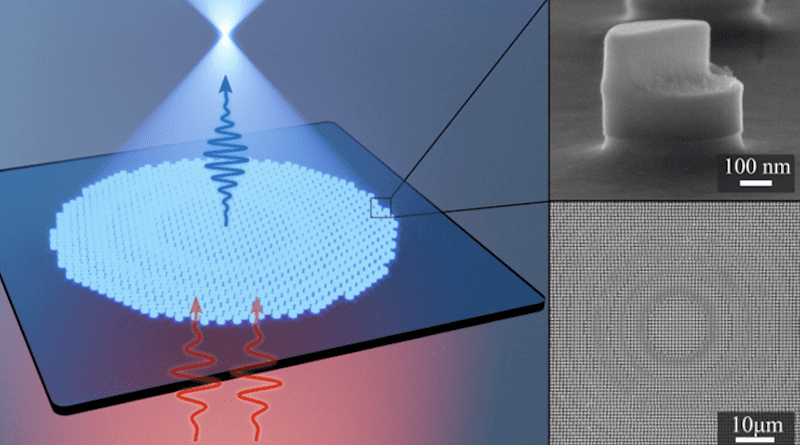Present And Future Of Nonlinear Optical Metasurfaces
One of the main objectives of optics is the control of light propagation and confinement. Progress in optics historically started with the development of bulky lenses and mirrors, then prisms and gratings, and so on. The improvement of these devices slew down as the diffraction limit was approached. Nanophotonics aims at manipulating electromagnetic waves at sub-wavelength scale to go beyond this limit. The recent evolution of fabrication technologies, numerical tools and theoretical models opened the way to novel devices with unprecedented performances.
Optical metasurfaces are arrays of optical antennas, with sub-wavelength size and separation. They represent an original concept of flat optics with no classical analogs. They allow for the ultimate miniaturization of optical components, as well as the enabler of new functionalities not possible to date. In the past two decades, the optical properties of metasurfaces have been intensely studied in the linear regime, with either metallic or amorphous dielectric nanostructures.
Recently, nonlinear flat optics has gained increasing attention, with frequency conversion effects observed firstly in the hot spots associated to localized plasmon resonances in metal nanoantennas and then in association to Mie-type multipolar resonances in dielectric nanostructures. In this transition to the nano-scale, the role of phase matching has been replaced by that of near-field resonances occurring in open non-Hermitian nanostructures.
In the new field of nonlinear metasurfaces, for which the name of nonlinear meta-optics has been proposed, dielectric implementations have provided the highest nonlinear generation efficiencies: firstly with third harmonic generation in amorphous or silicon-on-insulator platforms, and then with second harmonic generation and spontaneous parametric down-conversion in non-centrosymmetric materials like III-V semiconductors and lithium niobate. More recently, the scientific community became also interested in the wavefront shaping of the harmonic fields, ranging from simple meta-gratings and meta-lenses to nonlinear generation of complex meta-holograms and special beams.
The authors of this article review the recent progress in nonlinear optics with dielectric metasurfaces, focusing on the paradigmatic effect of second harmonic generation. They discuss the most used technological platforms which underpinned such advances and analyze different control approaches. Their paper begins with an introduction on the topic of nonlinear generation in sub-wavelength “Mie” resonators, pointing out the main figures of merit for a high efficiency in non-Hermitian systems. Then, they overview the main approaches adopted in recent years to control or boost harmonic generation in metasurfaces. They finally compare their performances with other well-established technologies, illustrating the current state-of-the-art and figure out a few scenarios in which these devices might soon offer unprecedented opportunities. In their conclusion, two possible outlooks emerge for the rapidly emerging domain of dielectric nonlinear metasurfaces.
On the one hand, resorting to coupled nanoantennas and collective resonances seems the wisest strategy to maximize nonlinear generation. However, also the metasurfaces exhibiting the largest quality factors are orders of magnitude less efficient than the other platforms. This outcome stems from the fact that to date most of the studies adopting this approach, focused on the creation of a single high-Q resonance around FF. Instead, is has to be expected that such gap with the other technologies may be filled with a careful design providing a good balance between free-space coupling and mode quality factors, while implementing a doubly resonant condition and optimizing the nonlinear overlap integral.
On the other hand, low-Q antennas represent a true change of paradigm with respect to both guided structures and photonic crystals. Their presently lower nonlinear generation efficiency is largely counterbalanced by intriguing possibilities ranging from the dynamic tunability of individual meta-atom emission, to pulse shaping, broadband parametric devices, nonlinear imaging, wavefront shaping and meta-holography. Their rapid development is currently underpinned by an ongoing progress in nanofabrication, new promising nonlinear materials like TMDCs, and both analytical and numerical methods to model nonlinear generation in leaky cavities. The improvement of such mathematical tools seems especially important for non-intuitive design and optimization of highly multi-mode nanoresonators.
Based on the impressive achievements of this new branch of nonlinear optics, it is reasonable to expect a new class of nonlinear photonic meta-devices to arise in the forthcoming years, for high-speed switching, entangled photon sources, supercontinuum generation and nonlinear imaging.

